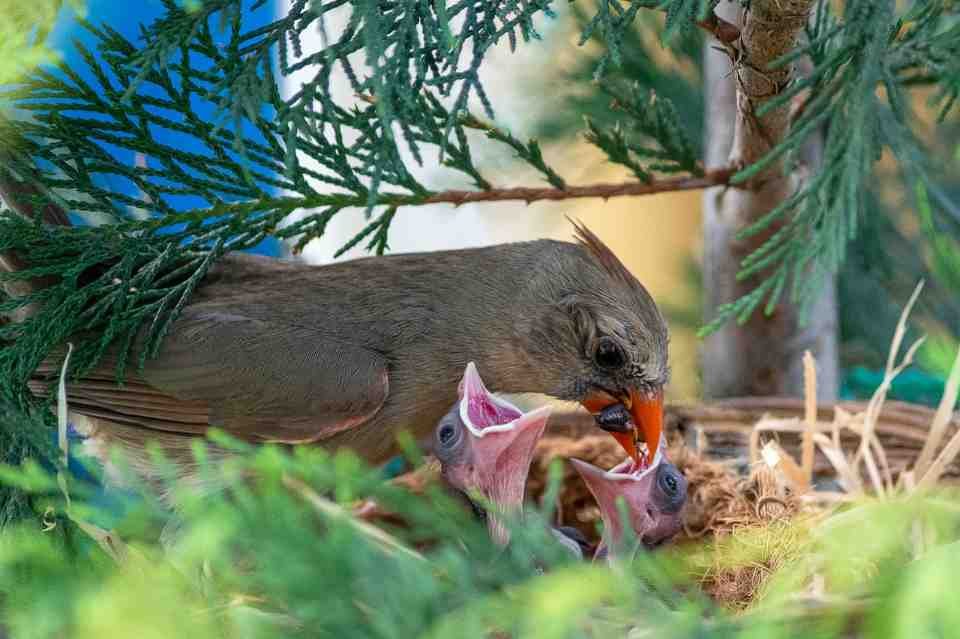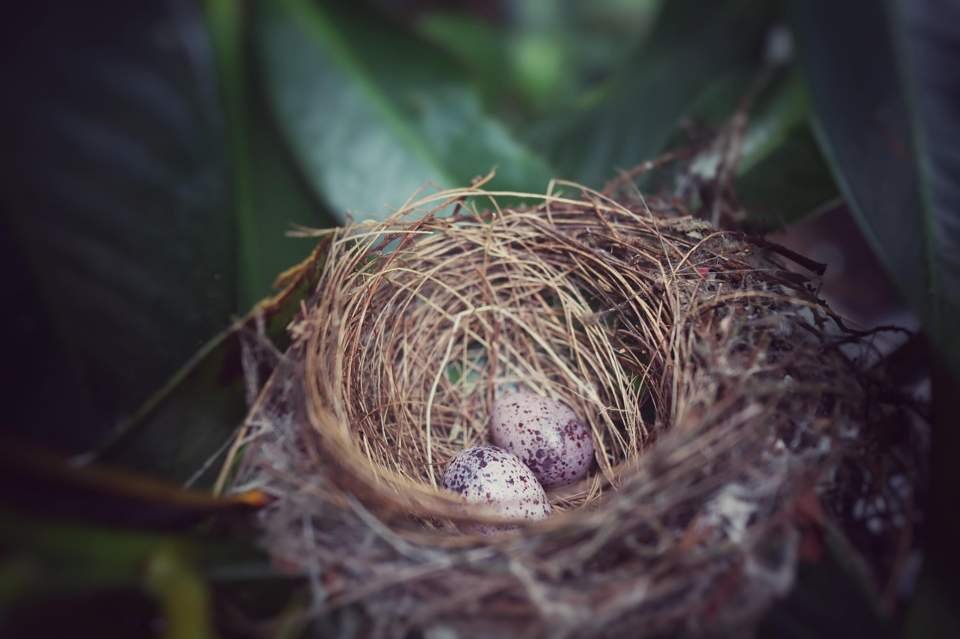I’ve lost count of how many times people ask me, “So, where do northern cardinals build their nests?” It sounds simple, right? You’d think they’d all pick the same type of spot. Spoiler: they don’t 😳. Cardinals are picky and practical at the same time, which makes their nesting habits fascinating if you’re even half as bird-obsessed as I am.
If you’ve ever seen a flash of red zip through your backyard and wondered where those little lovebirds are hiding their eggs, you’re in the right place. I’ll walk you through exactly where northern cardinals build their nests, what they look for in a location, and how you can spot one without turning into the creepy neighbor with binoculars glued to their face.
Why Cardinals Care So Much About Nest Placement
Think about it. If you were raising fragile, defenseless babies that can’t even open their eyes yet, would you just plop them in the middle of your front lawn? Nope. Neither do cardinals.
Cardinals pick nesting spots that check three boxes: safety, coverage, and convenience. Safety from predators, coverage from the weather, and convenience because mama cardinal isn’t about to fly three miles just to grab lunch. You can learn more about typical cardinal nesting locations and other interesting cardinal facts.
The result? They build in places that are low enough to be hidden but high enough to avoid becoming an easy snack for cats, snakes, or hawks. It’s like finding that “just right” spot Goldilocks kept talking about.
Typical Nesting Locations for Northern Cardinals
So, where exactly do these red-feathered parents set up shop? They’re surprisingly flexible. Here are the main types of spots they use.
Shrubs and Dense Bushes
This is the number one choice. Cardinals absolutely love dense shrubs with thick foliage because it gives them the perfect combo of camouflage and cover.
- Honeysuckle
- Dogwood
- Rose bushes
- Privet
If you’ve got one of these in your yard, chances are a cardinal has at least scoped it out. Personally, I’ve spotted more nests in my rose bushes than anywhere else, which made pruning season extra awkward.
Low Tree Branches
Unlike some birds that nest high up in towering trees, cardinals prefer low to mid-level branches, usually between 1 to 15 feet off the ground. Why? Because they like staying closer to the action (and the food).
If you see cardinals flitting around your oak, maple, or pine trees, don’t just look at the top. Check the lower branches.
Tangled Vines
Cardinals love a good vine jungle. Grape vines, Virginia creeper, or even ivy growing along fences can make perfect hideouts. The thick tangles give them a natural fortress that’s tough for predators to navigate.
Funny enough, I once found a cardinal nest inside my neighbor’s wisteria vine, which they’d been trying to “control” for years. Joke’s on them, the cardinals beat them to it.
Human-Made Structures
Yep, sometimes cardinals get creative. They’ll nest in things like:
- Hanging flower baskets
- Window ledges
- Potted plants on porches
- Even abandoned farm equipment (seriously, I’ve seen it)
It’s rare, but it happens. If you find yourself wondering why your hanging fern looks fuller than usual, it might not be the fertilizer, it might be a family of cardinals.
What Does a Cardinal Nest Look Like?
If you’ve never spotted one before, you might mistake it for just a messy clump of leaves. But cardinal nests have a very specific style.
Structure of a cardinal nest:
- Outer layer – Twigs, bark strips, and vines
- Middle layer – Grass, pine needles, and leaves
- Inner lining – Animal hair, fine grasses, or sometimes feathers
They’re about 2–3 inches tall and 4 inches across, which makes them look compact but cozy. Basically, the avian version of a tiny starter home.
And FYI, it’s usually the female cardinal who does most of the construction while the male keeps guard. Chivalry isn’t dead, it’s just feathered and red.
How Cardinals Choose the Perfect Spot
You might be wondering, “Okay, but what makes one bush better than another?” Here’s the checklist cardinals seem to use when house-hunting.
Location, Location, Location
- Near food: Cardinals are seed-eaters, so they like nesting near plants, feeders, or fields where they don’t have to commute for dinner.
- Near water: A bird bath, creek, or pond nearby makes life way easier.
Camouflage
Dense foliage is a must. If predators can spot the nest from a distance, it’s a no-go.
Accessibility
They don’t want to fight with thorns every time they fly in and out. Yes, roses work, but you’ll notice they often choose the spots where the branches open just enough for easy access.
Predator Awareness
Cardinals are smart. They’ll avoid spots that are too close to ground predators (like cats) but also don’t risk going too high where hawks patrol. It’s all about balance.
When Do Cardinals Build Their Nests?
Northern cardinals are early birds when it comes to nesting season. They usually start in March and keep going through August.
Fun fact: cardinals can raise up to two or even three broods per season. Once the first set of fledglings takes off, the parents start prepping a new nest, often just a few feet away from the old one. Talk about efficiency.
If you see a pair of cardinals hanging around the same bush for weeks, you’re probably watching a couple with a mortgage (well, a twig mortgage).
How to Spot a Cardinal Nest Without Disturbing It
Here’s the tricky part. You want to see the nest, but you don’t want to scare off the parents or worse, attract predators.
Tips for spotting nests safely:
- Watch the adults. Follow the female when she carries twigs or grass, she’ll basically give away the nest location.
- Listen for soft “chip” sounds. Parents often call quietly near the nest.
- Look low, not high. Remember, cardinals don’t build skyscrapers.
And please, don’t stick your hand in there to check for eggs. That’s a fast way to make mama cardinal mad and possibly abandon the nest.
How You Can Attract Cardinals to Nest in Your Yard
If you’d love to host a cardinal family, there are a few things you can do.
Plant Native Shrubs and Trees
Go for thick, leafy options like dogwood, serviceberry, or evergreens. These give cardinals the privacy they crave.
Provide Food and Water
Keep a reliable bird feeder stocked with sunflower seeds (their absolute favorite) and set up a bird bath. Cardinals are suckers for both.
Keep Things Quiet
Cardinals don’t love noisy or heavily trafficked spots. If your yard is a constant BBQ party zone, they’ll pass.
Skip the Birdhouses
Cardinals don’t use birdhouses. They prefer open, cup-shaped nests in shrubs or trees. If you set up a cardinal birdhouse, congrats, you just built them a fancy thing to ignore.
Common Misconceptions About Cardinal Nests
I hear these all the time, so let’s clear the air.
- “Cardinals nest high in trees.” Nope, they usually stay low.
- “They reuse the same nest every year.” False. They build a new one every season (sometimes multiple times).
- “If you touch the nest, the parents won’t come back.” Not exactly true. Birds don’t have a strong sense of smell. But disturbing the nest can scare them away, so just don’t.
Final Thoughts
So, where do northern cardinals build their nests? In short, they choose dense shrubs, low tree branches, tangled vines, or occasionally human-made spots that offer safety and easy access to food and water.
I’ve always thought cardinals were like the suburban parents of the bird world. They don’t want flashy penthouses or risky cliffside condos. They want a modest little bush near the feeder, close to the snacks, with enough cover to keep the kids safe. Can’t say I blame them.
Next time you see a pair of cardinals hanging around your yard, pay attention. You might just be neighbors with a brand-new nest, and if you’re lucky, you’ll get to watch the babies grow up before they fly off to start families of their own.
And hey, if you ever wondered why they don’t use those cute birdhouses you put out… now you know 🙂




